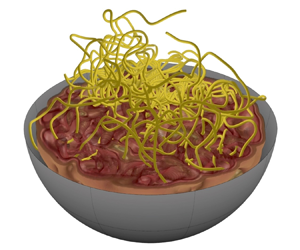Published online by Cambridge University Press: 01 March 2024

Over the last decade, substantial progress has been made in understanding the topology of quasi-two-dimensional (2-D) non-equilibrium fluid flows driven by ATP-powered microtubules and microorganisms. By contrast, the topology of three-dimensional (3-D) active fluid flows still poses interesting open questions. Here, we study the topology of a spherically confined active flow using 3-D direct numerical simulations of generalized Navier–Stokes (GNS) equations at the scale of typical microfluidic experiments. Consistent with earlier results for unbounded periodic domains, our simulations confirm the formation of Beltrami-like bulk flows with spontaneously broken chiral symmetry in this model. Furthermore, by leveraging fast methods to compute linking numbers, we explicitly connect this chiral symmetry breaking to the entanglement statistics of vortex lines. We observe that the mean of linking number distribution converges to the global helicity, consistent with the asymptotic result by Arnold [In Vladimir I. Arnold – Collected Works (ed. A.B. Givental, B.A. Khesin, A.N. Varchenko, V.A. Vassiliev & O.Y. Viro), pp. 357–375. Springer]. Additionally, we characterize the rate of convergence of this measure with respect to the number and length of observed vortex lines, and examine higher moments of the distribution. We find that the full distribution is well described by a k-Gamma distribution, in agreement with an entropic argument. Beyond active suspensions, the tools for the topological characterization of 3-D vector fields developed here are applicable to any solenoidal field whose curl is tangent to or cancels at the boundaries of a simply connected domain.